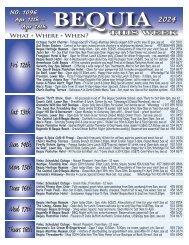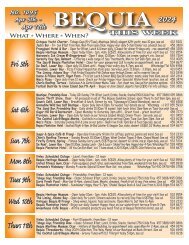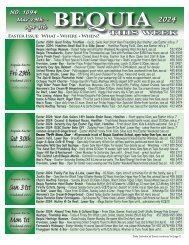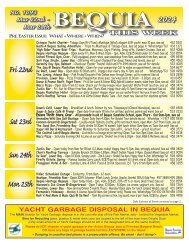Caribbean Compass Yachting Magazine - November 2020
Welcome to Caribbean Compass, the most widely-read boating publication in the Caribbean! THE MOST NEWS YOU CAN USE - feature articles on cruising destinations, regattas, environment, events...
Welcome to Caribbean Compass, the most widely-read boating publication in the Caribbean! THE MOST NEWS YOU CAN USE - feature articles on cruising destinations, regattas, environment, events...
You also want an ePaper? Increase the reach of your titles
YUMPU automatically turns print PDFs into web optimized ePapers that Google loves.
NOVEMBER <strong>2020</strong> CARIBBEAN COMPASS PAGE 16<br />
STEP UP TO<br />
EYEBALL<br />
NAVIGATION<br />
by Don Street<br />
When cruising and racing in the <strong>Caribbean</strong> Sea, the ability to “read” the water’s<br />
depth by its color and texture is an essential skill. This skill is known as eyeball<br />
navigation. You’ll quickly learn that dark indigo-blue water is deep, turquoise is<br />
shallower, and reefs are brownish, for example.<br />
You need to be able to see into the water when navigating in in reef-encumbered<br />
areas, and this is best done with the sun overhead. If you use common sense to avoid<br />
reflection and glare off the surface — i.e. not heading west to enter or leave harbors<br />
after 1500 hours, or heading east before 1100 — you can cruise the <strong>Caribbean</strong><br />
relying almost completely on eyeball navigation.<br />
Height of eye is a key factor — the higher your eyeballs are off the deck, the better<br />
your view into the water. Eyeball navigation is much better from the bow than from<br />
the cockpit. Standing on top of the bow pulpit is much better than standing on deck.<br />
And a crewmember piloting from the lower spreaders has an even better view.<br />
Unfortunately, with the almost universal use of GPS and chart plotters, eyeball<br />
navigation has largely been forgotten — sometimes with disastrous results.<br />
See the September 2014 issue of <strong>Compass</strong> (www.caribbeancompass.com/online/<br />
september14compass_online.pdf, page 27) and note the picture of a Swan 90 hard<br />
aground on the western side of Spithead Channel at Antigua’s Nonsuch Bay. The<br />
skipper was reportedly looking at his chart plotter rather than at the water. The<br />
salvage and repair cost ended up in the region of US$800,000.<br />
In contrast, my yawl Iolaire once departed Grenada on a one-month charter cruise<br />
to St. Thomas. It was the days before electronic navigation, and as we reached the<br />
northwest corner of Grenada, I discovered that our charts of the Grenadines had<br />
been left in the Grenada Yacht Club bar!<br />
'If someone is on the lower spreaders<br />
and the light is good,<br />
everything becomes crystal clear.<br />
Mast steps make climbing<br />
to the lower spreaders easy. '<br />
Neither I nor my 18-year-old crew, Ed Pionkowski, had ever sailed the Grenadines<br />
before, but I was not willing to go back to St. George’s to pick up the charts. So I told<br />
Ed to take two small cockpit cushions and secure one to the top of each lower<br />
spreader so an eyeball navigator sitting up there would be comfortable. (We had a<br />
flag halyard on the starboard spreader and we rigged another flag halyard on the<br />
port spreader so that no matter which tack we were on, the person on the spreader<br />
could be supplied with cold Heineken.)<br />
We spent a week cruising the Grenadines using only eyeball navigation. We even<br />
entered the Tobago Cays from the southern entrance, an entrance that today some<br />
bareboat managers and cruising guide authors claim is too difficult to use. But if you<br />
read the sailing instructions in the booklet that accompanies Imray Iolaire chart B31<br />
or B311 (or the piloting directions found in Street’s Guide Martinique to Trinidad),<br />
and if there is good light and an experienced eyeball navigator is in the spreaders or<br />
even on the foredeck, the southern entrance is quite do-able.<br />
In my early days of exploring the Eastern <strong>Caribbean</strong>, often without the aid of a<br />
detailed chart, I or one of my crew would spend a lot of time conning Iolaire from<br />
the lower spreader. Until I reached my middle 70s, with the aid of the external<br />
halyards I could still climb Iolaire’s mast without a bosun’s chair. Then I started<br />
sailing Li’l Iolaire, a 28-foot yawl that had an aluminium mast with internal<br />
halyards. Because of the internal halyards, it was almost impossible for me to climb<br />
Li’l Iolaire’s mast, so I installed steps to the lower spreaders. The mast steps made<br />
climbing to the lower spreaders easy and I did it regularly when entering harbors<br />
and exploring new anchorages.<br />
In some areas, such as parts of the Western <strong>Caribbean</strong>, electronic charts aren’t<br />
very accurate. But I think every skipper of every cruising yacht in the <strong>Caribbean</strong> will<br />
realize that now, with internal halyards almost universal, the chances of having a<br />
crewmember climb to the lower spreader to con the boat is zero — unless the mast<br />
has steps.<br />
So, before the next cruising season starts, check the various catalogues, find mast<br />
steps that appeal to you and install them as far as the lower spreaders. Installing<br />
mast steps is a job that you can do with the mast in the boat. A tip: run some light<br />
line, such as Dyneema, between the outboard ends of the steps to keep halyards<br />
from getting fouled.<br />
Whenever there is a tricky pilotage situation, if someone is on the lower spreaders<br />
and the light is good, everything becomes crystal clear.<br />
As a bonus, at anchor those crewmembers who are too nervous to go aloft under<br />
sail can climb the mast via the steps (plus a bosun’s chair for the “belt and<br />
suspenders” effect) and obtain wonderful views and photographs that are not<br />
available from deck level.<br />
So step on up. The view from the lower spreaders is great!<br />
Throughout this, our Silver Jubilee Year, <strong>Caribbean</strong> <strong>Compass</strong> is proud to share<br />
articles from our archives. A version of this article first appeared in <strong>November</strong> 2016<br />
— and information is just as useful today.

















